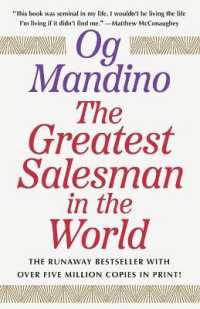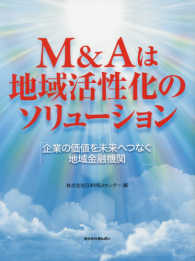- ホーム
- > 洋書
- > 英文書
- > History / World
Full Description
This volume explores various perceptions, adaptations and appropriations of both the personality and the writings of Horace in the early modern age. The fifteen essays in this book are devoted to uncharted facets of the reception of Horace and thus substantially broaden our picture of the Horatian tradition. Special attention is given to the legacy of Horace in the visual arts and in music, beyond the domain of letters. By focusing on the multiple channels through which the influence of Horace was felt and transmitted, this volume aims to present instances of the Horatian heritage across the media, and to stimulate a more thorough reflection on an interdisciplinary and multi-medial approach to the exceptionally rich and variegated afterlife of Horace.
Contributors: Veronica Brandis, Philippe Canguilhem, Giacomo Comiati, Karl A.E. Enenkel, Carolin A. Giere, Inga Mai Groote, Luke B.T. Houghton, Chris Joby, Marc Laureys, Grantley McDonald, Lukas Reddemann, Bernd Roling, Robert Seidel, Marcela Slavíková, Paul J. Smith, and Tijana Žakula.
Contents
List of Illustrations
Notes on the Editors
Notes on the Contributors
1 Some Introductory Thoughts on the Reception of Horace in the Early Modern Age
Marc Laureys
Part 1: The Reception of the Ars Poetica as a Model for the Theory of Painting, Drama, Diplomacy, Cookery and Other Arts
2 Rethinking Horace in Dutch Classicist Art Theory and in the Theory of Poetry and Drama: Gerard de Lairesse and Andries Pels
Tijana Žakula
3 From Poetry to Cookery, Architecture, and Stock-Jobbing: Imitation and Parodia of Horace's Ars Poetica in 18th-Century England
Lukas Reddemann
Part 2: The Reception of Horace in the Visual Arts
4 The Reception of Horace in the Visual Arts, 15th Century until ca. 1840: A First Exploration
Karl A.E. Enenkel
5 Vaenius's Pluri-Medial Horace: Images for Contemplation, Primer of Philosophy, Iconological Templates for Artists, Latin Commonplace Book, and Vernacular Emblem Book
Karl A.E. Enenkel and Paul J. Smith
Part 3: Horace and Music
6 Before Melopoiae: Conrad Celtis, Laurentius Corvinus, Arnold Wöstefeld and the Use of Music in the Teaching and Performance of Horace's Metres around 1500
Grantley McDonald
7 Horace among Early Modern Teachers and Music Theorists: Poetics and Songs
Inga Mai Groote
8 Singing Horace in Sixteenth-Century France: A Reappraisal of the Sources and Their Interpretation
Philippe Canguilhem
Part 4: Other Materializations of Horace: School Book Production and Funeral Inscriptions
9 Librum pulcherrimum et utilissimum edidit: Editions of Horace by Johannes Honorius Cubitensis (c.1465-1504)
Marcela Slavíková
10 Horace and Sepulchral Sapphics - Some English Examples
Luke B.T. Houghton
Part 5: The Reception of the Odes in Early Modern Lyrical Poetry
11 The Reception of the "Horatian Hymn" in Quattrocento Neo-Latin Poetry: Aurelius Laurentius Albrisius and Giovanni Pontano
Carolin A. Giere
12 Horace across Seventeenth-Century Italian Literature: Carlo de' Dottori and his Odes
Giacomo Comiati
13 "As closely as possible after the model of Horace"? Degrees of Horatianism in James Alban Gibbes' Lyric Poetry
Marc Laureys
14 On the Reception of Horace's Carmen Saeculare in the Early Modern Period
Veronika Brandis and Robert Seidel
Part 6: Horatian Topics and Commonplaces
15 John Cruso of Norwich and the Reception of Horatius Sententiosus in Early Modern Provincial England
Christopher Joby
16 De laudibus vitae rusticae: Horace's Second Epode and the Tradition of Georgic Poetry
Bernd Roling
Index Nominum








